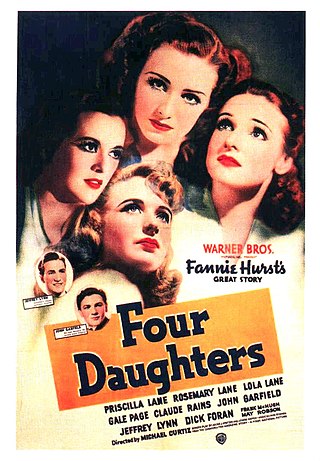
Four Daughters is a 1938 American romance film that tells the story of a happy musical family whose lives and loves are disrupted by the arrival of a charming young composer who interjects himself into the daughters' romantic lives. His cynical, bitter musician friend comes to help orchestrate his latest composition and complicates matters even more. The movie stars the Lane Sisters and Gale Page, and features Claude Rains, Jeffrey Lynn, John Garfield, and Dick Foran. The three Lanes were sisters and members of a family singing trio.
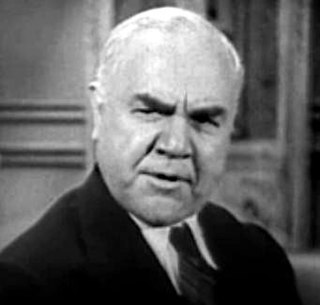
Berton Churchill was a Canadian stage and film actor.

Ossining is a town located along the Hudson River in Westchester County, New York. The population was 40,061 at the time of the 2020 census. It contains two villages, the Village of Ossining and part of Briarcliff Manor, the rest of which is located in the Town of Mount Pleasant. Ossining is the location of Sing Sing maximum-security prison.

Sing Sing Correctional Facility, formerly Ossining Correctional Facility, is a maximum-security prison operated by the New York State Department of Corrections and Community Supervision in the village of Ossining, New York. It is about 30 miles (48 km) north of New York City on the east bank of the Hudson River. It holds about 1,700 inmates and housed the execution chamber for the State of New York until the abolition of capital punishment in New York in 1977.

Clara Lou "Ann" Sheridan was an American actress and singer. She is best known for her roles in the films San Quentin (1937) with Humphrey Bogart, Angels with Dirty Faces (1938) with James Cagney and Bogart, They Drive by Night (1940) with George Raft and Bogart, City for Conquest (1940) with Cagney and Elia Kazan, The Man Who Came to Dinner (1942) with Bette Davis, Kings Row (1942) with Ronald Reagan, Nora Prentiss (1947), and I Was a Male War Bride (1949) with Cary Grant.

Lewis Edward Lawes was a prison warden and a proponent of prison reform. During his 21-year tenure at Sing Sing Correctional Facility, he supervised the executions of 303 prisoners.
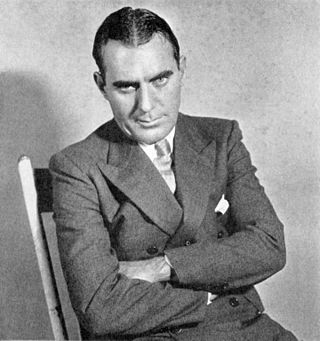
William Joseph Patrick O'Brien was an American film actor with more than 100 screen credits. Of Irish descent, he often played Irish and Irish-American characters and was referred to as "Hollywood's Irishman in Residence" in the press. One of the best-known screen actors of the 1930s and 1940s, he played priests, cops, military figures, pilots, and reporters. He is especially well-remembered for his roles in Knute Rockne, All American (1940), Angels with Dirty Faces (1938), and Some Like It Hot (1959). He was frequently paired onscreen with Hollywood star James Cagney. O'Brien also appeared on stage and television.

John Elmer Carson, known as Jack Carson, was a Canadian-born American film actor. Carson often played the role of comedic friend in films of the 1940s and 1950s, including The Strawberry Blonde (1941) with James Cagney and Arsenic and Old Lace (1944) with Cary Grant. He appeared in such dramas as Mildred Pierce (1945), A Star is Born (1954), and Cat on a Hot Tin Roof (1958). He worked for RKO and MGM, but most of his notable work was for Warner Bros.

Invisible Stripes is a 1939 Warner Bros. crime film starring George Raft as a gangster unable to go straight after returning home from prison. The movie was directed by Lloyd Bacon and also features William Holden, Jane Bryan and Humphrey Bogart. The screenplay by Warren Duff was based on the novel of the same title by Warden Lewis E. Lawes, a fervent crusader for prison reform, as adapted by Jonathan Finn.

20,000 Years in Sing Sing is a 1932 American pre-Code drama film set in Sing Sing Penitentiary, the maximum security prison in Ossining, New York, starring Spencer Tracy as an inmate and Bette Davis as his girlfriend. It was directed by Michael Curtiz and based on the nonfiction book, Twenty Thousand Years in Sing Sing, written by Lewis E. Lawes, the warden of Sing Sing from 1920 to 1941.
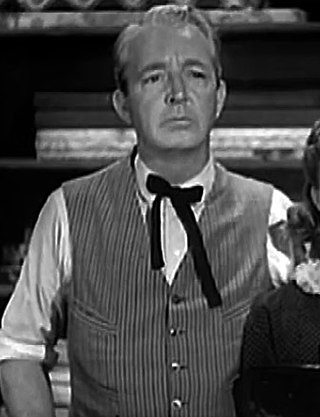
Edwin Stanley, was an American film actor. He appeared in more than 230 films between 1916 and 1946. He was born in Chicago, Illinois and died in Hollywood, California. On Broadway, Stanley appeared in This Man's Town (1930), The Marriage Bed (1929), and The Donovan Affair (1926). Stanley was also a playwright.

John Grant Mitchell Jr. was an American actor. He appeared on Broadway from 1902 to 1939 and appeared in more than 125 films between 1930 and 1948.
Seton Ingersoll Miller was an American screenwriter and producer. During his career, he worked with film directors such as Howard Hawks and Michael Curtiz. Miller received two Oscar nominations and won once for Best Screenplay for the 1941 fantasy romantic comedy film, Here Comes Mr. Jordan, along with Sidney Buchman.
San Quentin is a 1937 Warner Bros. drama film directed by Lloyd Bacon and starring Pat O'Brien, Humphrey Bogart, and Ann Sheridan. It was shot on location at San Quentin State Prison.

Flowing Gold is a 1940 American adventure film starring John Garfield, Frances Farmer, and Pat O'Brien. It was based on the novel of the same name by Rex Beach. The novel had already been adapted to film in 1924 but that was in silent form. The 1940 film with audible dialogue is set in the American oilfields and the title refers to oil.
Swingtime in the Movies is a 1938 American short comedy–musical film directed and written by Crane Wilbur. In 1939, it was nominated for an Academy Award for Best Live Action Short Film, Two-Reel at the 11th Academy Awards. Swingtime in the Movies is included on the DVD of the 1940 Raoul Walsh film They Drive By Night.
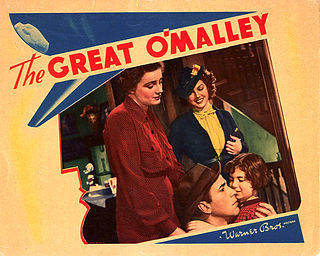
The Great O'Malley is a 1937 American crime drama film directed by William Dieterle and starring Pat O'Brien, Sybil Jason, Humphrey Bogart, and Ann Sheridan. The 1925 silent version The Making of O'Malley starred Milton Sills, Dorothy Mackaill and Helen Rowland.

Over the Wall is a 1938 American drama film directed by Frank McDonald and written by Crane Wilbur and George Bricker, based on a story by Lewis E. Lawes. The film stars Dick Foran, June Travis, John Litel, Dick Purcell, Veda Ann Borg and George E. Stone. The film was released by Warner Bros. on April 2, 1938.

Indianapolis Speedway is a 1939 American drama film directed by Lloyd Bacon and written by Sig Herzig and Wally Kline.The film stars Ann Sheridan, Pat O'Brien, John Payne, Gale Page, Frank McHugh and Grace Stafford. The film was released by Warner Bros. on August 5, 1939.

Adrian Michael Morris was an American actor of stage and film, and a younger brother of Chester Morris.

















